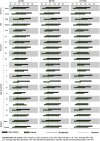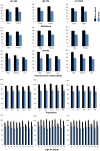Estimating the inbreeding depression on cognitive behavior: a population based study of child cohort
- PMID: 25313490
- PMCID: PMC4196914
- DOI: 10.1371/journal.pone.0109585
Estimating the inbreeding depression on cognitive behavior: a population based study of child cohort
Erratum in
- PLoS One. 2014;9(12):e115393
Abstract
Background: Cognitive ability tests are widely assumed to measure maximal intellectual performance and predictive associations between intelligence quotient (IQ) scores and later mental health problems. Very few epidemiologic studies have been done to demonstrate the relationship between familial inbreeding and modest cognitive impairments in children.
Objective: We aimed to estimate the effect of inbreeding on children's cognitive behavior in comparison with non-inbred children.
Methodology: A cohort of 408 children (6 to 15 years of age) was selected from inbred and non-inbred families of five Muslim populations of Jammu region. The Wechsler Intelligence Scales for Children (WISC) was used to measure the verbal IQ (VIQ), performance IQ (PIQ) and full scale IQ (FSIQ). Family pedigrees were drawn to access the family history and children's inbred status in terms of coefficient of inbreeding (F).
Results: We found significant decline in child cognitive abilities due to inbreeding and high frequency of mental retardation among offspring from inbred families. The mean differences (95% C.I.) were reported for the VIQ, being -22.00 (-24.82, -19.17), PIQ -26.92 (-29.96, -23.87) and FSIQ -24.47 (-27.35,-21.59) for inbred as compared to non-inbred children (p<0.001) [corrected].The higher risk of being mentally retarded was found to be more obvious among inbred categories corresponding to the degree of inbreeding and the same accounts least for non-inbred children (p<0.0001). We observed an increase in the difference in mean values for VIQ, PIQ and FSIQ with the increase of inbreeding coefficient and these were found to be statistically significant (p<0.05). The regression analysis showed a fitness decline (depression) for VIQ (R2 = 0.436), PIQ (R2 = 0.468) and FSIQ (R2 = 0.464) with increasing inbreeding coefficients (p<0.01).
Conclusions: Our comprehensive assessment provides the evidence for inbreeding depression on cognitive abilities among children.
Conflict of interest statement
Figures







References
-
- American Psychiatric Association (2013) The diagnostic and statistical manual of mental disorders DSM 5. Bookpoint US.
-
- Lynn R, Vanhanen T (2012) National IQs: A review of their educational, cognitive, economic, political, demographic, sociological, epidemiological, geographic and climatic correlates. Intelligence 40: 226–234.
Publication types
MeSH terms
LinkOut - more resources
Full Text Sources
Other Literature Sources

